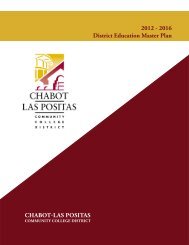City College of San Francisco - California Competes
City College of San Francisco - California Competes
City College of San Francisco - California Competes
Create successful ePaper yourself
Turn your PDF publications into a flip-book with our unique Google optimized e-Paper software.
STANDARD III.A<br />
smallest per employee within the <strong>California</strong><br />
community college system. 2 Approximately<br />
40 administrators are responsible for overseeing<br />
the nearly 3,000 employees (active adjunct<br />
faculty fluctuate from one semester to the next)<br />
and more than 98,000 students served throughout<br />
the <strong>College</strong>’s campuses.<br />
Staffing needs are directly linked to departmental<br />
objectives and responsibilities, which in<br />
turn are linked to institutional priorities. The<br />
relationship between the planning and budgeting<br />
process and employee positions allocations<br />
is aligned with the District’s End-<strong>of</strong>-Year<br />
Assessment Report and the Management Plan.<br />
[Refs. 41, 42] The Annual Plan is used as the<br />
basis for developing specific unit plans prepared<br />
by administrators and other supervisory personnel.<br />
[Ref. 43] The unit plans and respective<br />
budget requests are incorporated in the annual<br />
budget review and the allocation process. As<br />
a component <strong>of</strong> planning, administrators and<br />
supervisory personnel are required to indicate<br />
resources needed for completion <strong>of</strong> their objectives,<br />
including staffing. Positions allocation<br />
for all employees is a Shared Governance process<br />
aligned with <strong>College</strong> goals, strategic priorities,<br />
and financial resources.<br />
Once the allocation <strong>of</strong> resources is identified,<br />
administrators, supervisory personnel, department<br />
heads, and other staff responsible for<br />
hiring work with the Human Resources<br />
Department to fill their staffing needs as indicated<br />
in the respective hiring documents. [Refs. 1,<br />
2, 3] As an example, the Faculty Positions<br />
Allocation Committee (FPAC) plays the key role<br />
in setting the priorities for the hiring <strong>of</strong> new<br />
faculty. FPAC is a Shared Governance committee<br />
comprised <strong>of</strong> three administrators and three faculty.<br />
Departments submit their FPAC requests<br />
(FPAC request form) as per the criteria and procedures<br />
established by the Committee. [Ref. 16]<br />
The Committee utilizes the Decision Support<br />
System (DSS) data to assess faculty position<br />
requests. The DSS consists <strong>of</strong> four database<br />
modules: (1) student demands for courses and<br />
sections; (2) enrollment productivity; (3) student<br />
headcount and characteristics; and (4) student<br />
success. FPAC prioritizes the requests using the<br />
DSS as indicators <strong>of</strong> supply and demand for a<br />
particular course/subject and presents the list<br />
to the Planning and Budgeting Council (PBC)<br />
who determines the total number <strong>of</strong> full-time<br />
positions to be filled <strong>College</strong>-wide. The PBC<br />
recommendations are subject to the Chancellor’s<br />
approval.<br />
The Chancellor has primary responsibility for<br />
the allocation <strong>of</strong> the Administrative structure.<br />
If it is determined that an administrative position<br />
is needed to ensure the effective operation<br />
<strong>of</strong> <strong>College</strong> services, top administration consults<br />
with the Academic Senate. If the position is new,<br />
the Human Resources Department will be called<br />
in to conduct a job analysis survey, determining<br />
in consultation with the Chancellor and/or Vice<br />
Chancellor the appropriate job duties and<br />
responsibilities, as well as the respective salary<br />
and benefits. After the availability <strong>of</strong> funds is<br />
determined, a request accompanied by a justification<br />
and a job description is sent to the<br />
Executive Council <strong>of</strong> the Academic Senate for<br />
review. The Executive Council <strong>of</strong> the Academic<br />
Senate is empowered to make its own recommendations<br />
on the request and job description.<br />
If the Senate and Administration cannot agree<br />
on the job description, the final determination<br />
falls to the Chancellor. Recommendations for<br />
amendments to the hiring procedures are made<br />
by the Chancellor in consultation with the<br />
Academic Senate and taken before the Board<br />
<strong>of</strong> Trustees for review and adoption.<br />
Faced with a slow state recovery and impending<br />
budget restrictions, the District sought, among<br />
other things, to impose a hiring freeze in the<br />
classified unit. The approval for filling classified<br />
vacancies shifted from the Classified Positions<br />
Allocation Committee (CPAC), a Shared<br />
Governance committee, to the Vice Chancellors,<br />
who determined filling vacancies on a case-bycase<br />
basis. Consequently, the job analysis and<br />
comparison analysis components (District-wide<br />
analysis comparing a requested job’s duties/<br />
functions to positions essentially similar in type,<br />
difficulty, and responsibility <strong>of</strong> work performed)<br />
were temporarily inactivated. Much discussion<br />
about the need to re-implement this process<br />
<strong>of</strong> analysis has taken place in the Joint Labor<br />
2 This analysis does not include classified managers.<br />
174 CITY COLLEGE OF SAN FRANCISCO







